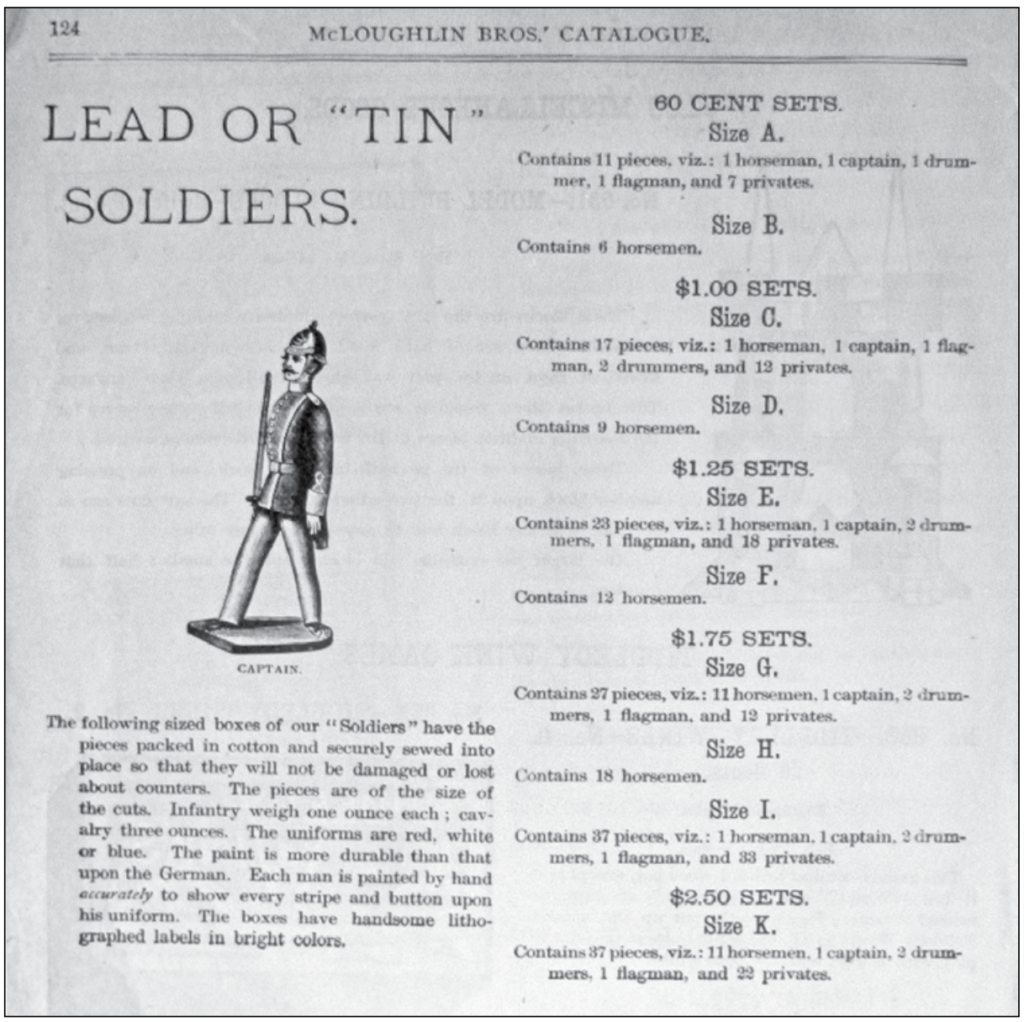
McLoughlin Brothers, a major American producer of paper lithographed toys and games, was
founded in 1857 by John McLoughlin but developed by his sons (aka “brothers”) John (1827-1905) and
Edmund (1833-1889) in New York City. From them, John’s sons James and Charles took over management of the company. In 1920, the company was purchased by their rival Milton Bradley. They were a major player in the world of American paper color lithography, producing a staggering catalog of colorful toys and games in paper and heavy cardstock.
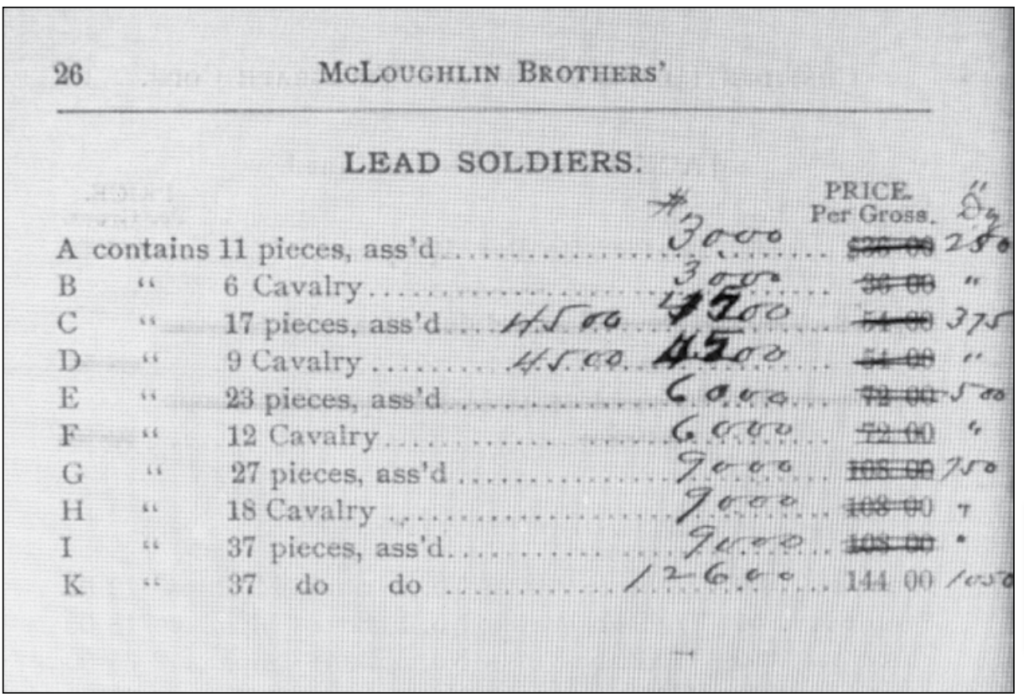
Somewhat out of character, McLoughlin did start making a very limited range of metal toy soldiers. While they began their printing business in 1857, it is not until 38 years later in their 1895 catalog that we see the introduction of metal toy soldiers (see Figure 1). This date is reinforced by a 1895
McLoughlin company stock list (from the American Antiquarian Society, Figure 2) showing bulk orders and wholesale discounts of their toy soldiers. Interestingly, despite an extensive and wide-ranging catalog of paper-based toys from very early on, this was also the first year in which they introduced their paper soldiers.
Many early toy soldier books and articles (and even current eBay listings) refer to unidentified soldiers
in American uniforms, especially German hollowcast in 48-54 mm scale, as made by McLoughlin. Richard O’Brian attributes this myth as perpetuated by the late legendary dealer and toy soldier expert, Gus Hansen, who suggested a popular Mechanics advertisement in 1925 showed a hollow-cast Rough Rider that was (presumably) from McLoughlin. Since the company dissolved in 1920, this is highly unlikely. Figures from the reference and date, if reliable, might be from Feix molds purchased when that company ceased production around that time (see OTS 2023, 47:3, pp 58- 60).

German production on the right.
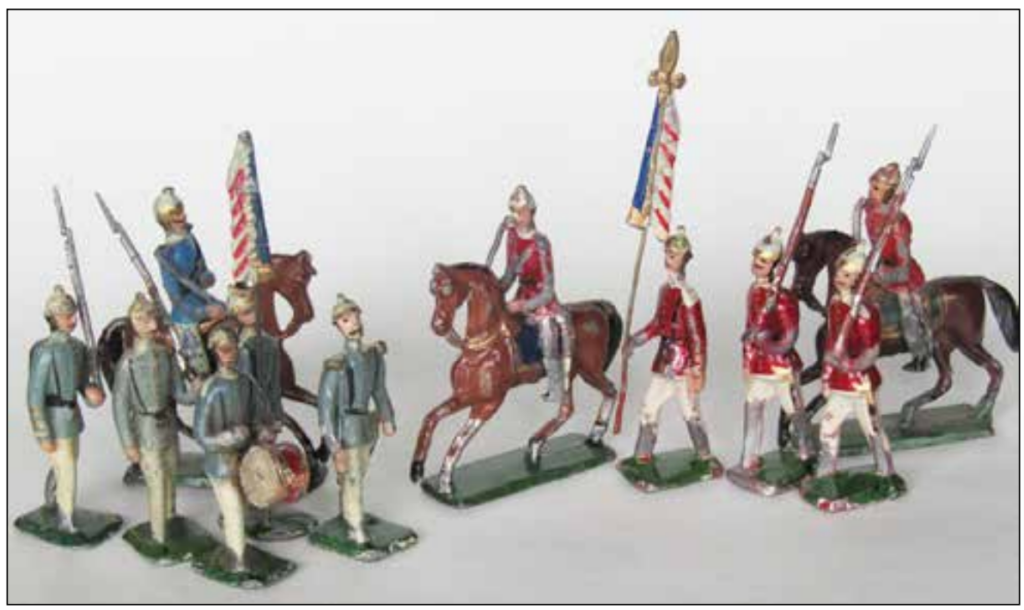
Unlike the figures of Beiser/Eureka and Feix, the McLoughlin metal figures were small, solid cast and very much in the tradition of the German makers of the time. They were fully round (ronde-bosse) rather than flats, similar to their German counterparts. Being solid-cast they can be produced in simple 2-piece molds which could have easily come from a local craftsman, or possibly were imported from Germany. Richard O’Brian states that while they are produced in the German style, they are NOT from German molds, and characterizes them as “grotesque” copies of Heyde (a little harsh).

German production on the right.
Because of the consistency of military fashion at the end of the 19th Century, the only thing distinguishing them from German or English uniforms was the color scheme. There were two basic figures involved. A single marching pose in spiked helmet was the primary foot figure. He was issued with either a rifle (private), a sword (captain), a flag (flagman) or a drum (drummer), all of which were soldered on to the basic figure. The mounted figure (horseman) served as an officer for some infantry sets or in larger numbers as cavalry. The latter carried a sword, and an officer was not distinguished in cavalry sets. While similar in appearance to German castings like Heyde, they were a little smaller and not as robust in their sculpting. The bases of these figures are considerably thicker than those of their German counterparts.
Every set could be purchased in one of initially three, and then later four color schemes for the tunic. These included a white tunic (Figure 3) with light blue trousers, a red tunic with white trousers
(Figure 4), a pale blue tunic with white trousers, and (added later) a grey tunic with white trousers. This expanded the line 4-fold without adding any new castings. Note that the grey figures are not listed in the (early) catalog options. The grey option seems to have come along later, perhaps after 1900. Not surprisingly, the box art and color lithography for the McLoughlin metal soldiers far eclipsed the quality of the figures themselves (see Figures 6 and 7).

Brothers Cavalry set.
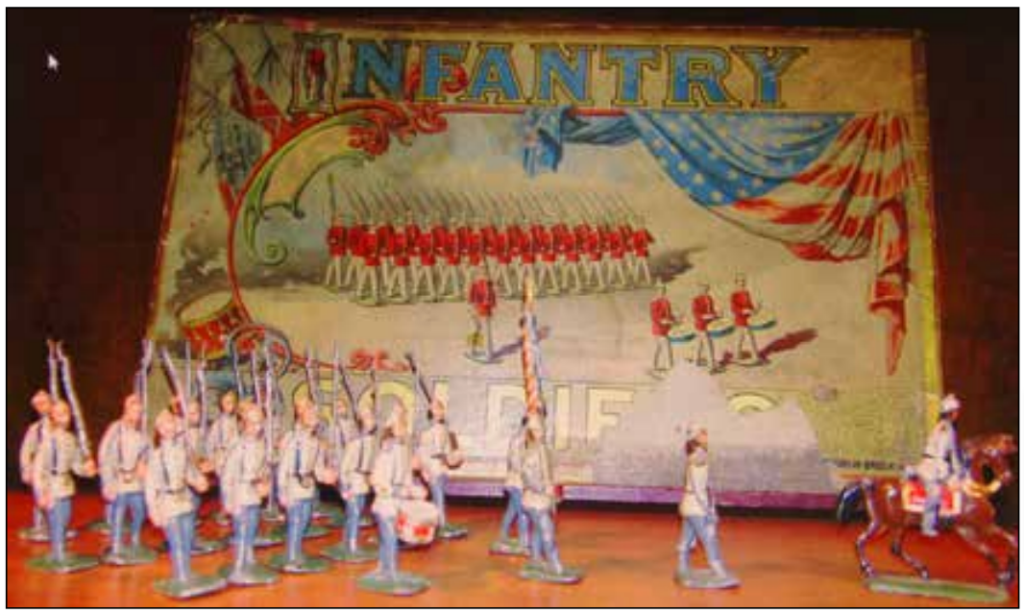
along with the set contents.
In McLoughlin’s 1895 catalog, on page 124, they introduce new lead or “tin” soldiers, along with a line
drawing of the marching officer (“Captain”). Catalogs prior to 1895 contained no listings of paper or
metal toy soldiers. Note that this corrects the assumptions of Richard O’Brian and Bill Nutting (in Richards “Collecting American-made Toy Soldiers,” page 18) that the first metal toy soldier production of McLoughlin was not introduced until 1911. The page in the 1895 catalog reads:
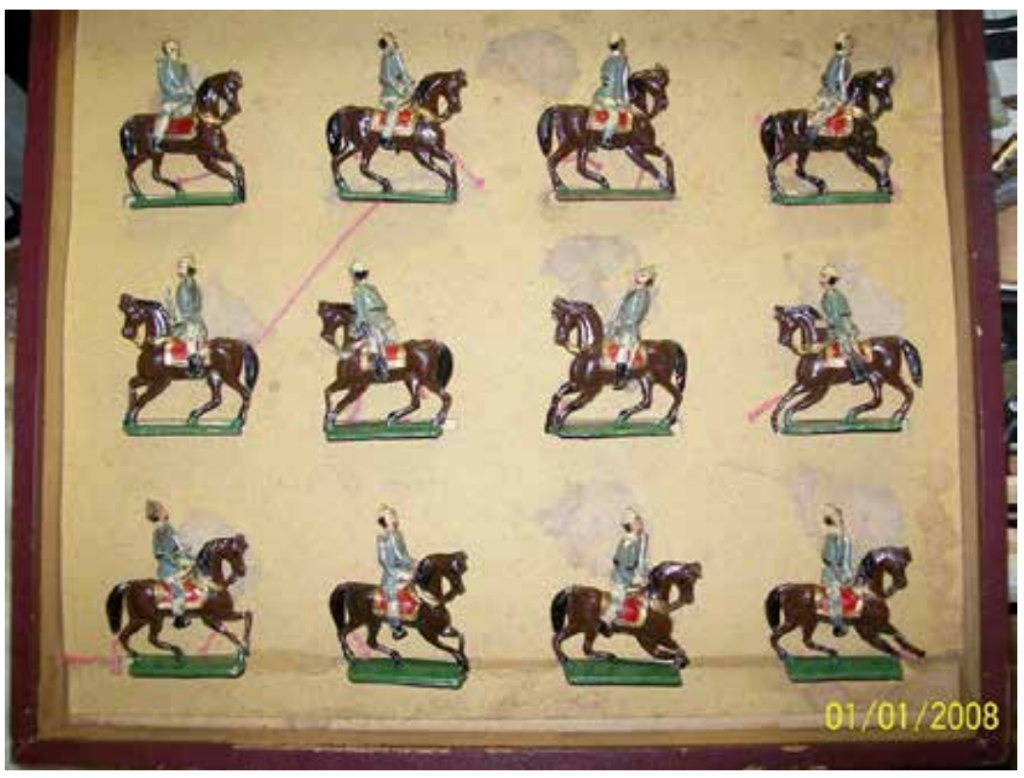
“The following sized boxes of our “Soldiers” have the pieces packed in cotton and securely sewed into place so that they will not be damaged or lost about counters. The pieces are of the size of the cuts. Infantry weigh one ounce each; cavalry three ounces. The uniforms are red, white or blue. The paint is more durable than that upon the German. Each man is painted by hand accurately to show every stripe and button upon his uniform. The boxes have handsome lithographed labels in bright colors.”
Note that because McLoughlin Brothers was already well established in the toy market in the latter part of the 19th century, their production of both paper (and heavy card) and metal toy soldiers had a ready and wide market and distribution system beyond what other minor producers might possibly be able to achieve. It is notable that while most production of toy soldiers in the American market up until the
first world war was presented in a format as “games” (10-pins, pop guns, the Beiser/Eureka hinged
board, etc.). McLoughlin’s production (for both paper and metal) included games, but also made sets (and even singles) of soldiers to be played with as just soldiers, and let the child’s imagination take over command of the regiments. This was pretty much a novel concept in American toy production in the pre-World War One era.

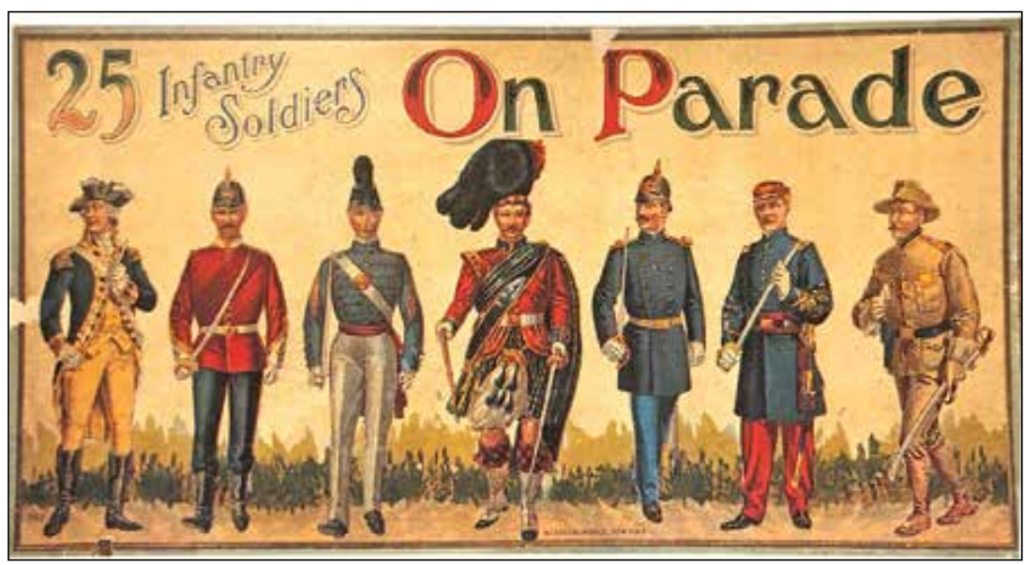
The catalog lists the following options:
60 Cent SETS
Size A contains 11 pieces, viz.:
1 horseman, 1 captain, 1 drummer,
1 flagman and 7 privates. Size B contains 6 horsemen.
$1.00 SETS
Size C contains 17 pieces, viz.:
1 horseman, 1 captain, 1 drummer,
1 flagman and 13 privates.
Size D contains 9 horsemen.
$1.25 SETS
Size E contains 23 pieces, viz.:
1 horseman, 1 captain, 2 drummers,
1 flagman and 18 privates.
Size F contains 12 horsemen.
$1.75 SETS
Size G contains 27 pieces, viz.:
11 horsemen, 1 captain, 2 drummers,
1 flagman and 12 privates.
Size H contains 18 horsemen.
Size I contains 37 pieces, viz.:
1 horseman, 1 captain, 2 drummers, 1 flagman and 32 privates.
$2.50 SETS
Size K containing 37 pieces, viz.:
11 horsemen, 1 captain, 2 drummers,
1 flagman and 22 privates.
There are no further significant changes in the tin soldier listings. A set size J was never cataloged, but
may have been held for some future (unreleased) set. The catalog of metal soldiers stays pretty static up until 1914 or 1915 when McLoughlin decided to cease production of these fellows. The only apparent change was the addition of a line drawing of the flagman in the 1911 and 1914 catalogs, and offering figures in grey as previously discussed. Otherwise, the contents remained similar. This, despite the fact that the paper catalog was expanding incredibly with new paper toy soldiers, soldiers in a variety of uniforms from around the world, soldier-based games, and exploiting current events such as the Spanish American War, the Great White Fleet and even Teddy Roosevelt’s popularity. If you are interested in the magnificent paper production of McLoughlin, Ed Ryans’ comprehensive, huge and colorful volume “Collecting Paper Soldiers” is the absolute standard reference and is a delight to read
and drift through the many colorful illustrations.
I used to think that the metal toy soldier production of McLoughlin (1896-1920), Beiser/Eureka (1898- 1928) and William Feix (1902-1925) represented the early beginnings of American-made metal production. Certainly, these were the “Big Three” due to their expanded catalogs, the variety and quality they produced, and their ability to market to a wide audience throughout much of the USA. However, in the last few issues of “Old Toy Soldier,” we have been treated to some unusual findings
regarding even earlier American production of metal toy soldiers.
Robin Forsey’s article (OTS 2022, 46: 3, pp 61-70) on Peter F. Pia presents evidence that there were metal soldiers made in the United States possibly in the 1850s, and some documented in 1867. These were pewter toys/flats made in the US, including soldiers (though no reference is provided). Forsey
speculates that the Italian immigrant Pia family business made pewter toys, including some soldiers, as
early as the first half of the 1860s, but unfortunately has been unable to document any specific evidence of dates for some limited examples marked “PIA” that were made in this early period or later in the 1880s. He does provide a lot of circumstantial evidence supporting this concept. These toys most likely had a very limited and local distribution, probably primarily to local retailers.
Regardless, the few and rare commercial examples of pewter flats marked PIA suggest these were some of the earliest of American metal toy soldier production in or shortly after the American Civil War. In the fall of 2023 and the spring 2024 issues of “Old Toy Soldier,” Gisbert Freber documented the remarkable early German flats that were made in America by the Master-Pewter caster Taugott Kinkeldey, using molds he brought with him to America from Stettin, Germany. He arrived in New York in 1856 with a suitcase full of slate molds. Thanks to the common nature of military fashion, the figures produced from these German molds could be painted to represent American soldiers, primarily from the American Revolution or the mid19th century. He apparently had the skillset to produce more molds, many of which are illustrated in Gisbert’s articles. Like the Pia figures, though the scope and variety of production is much greater, these were probably limited to a local market which contributes to their rarity. While it is not at all clear just how successful this venture was commercially, or how long after his arrival he continued to produce his American flats, he was clearly a pioneer in American metal
toy soldier production. If you have not yet read Gisbert’s fascinating and well-illustrated articles, I recommend them to you.
It has been documented that toy soldiers, in particular German ZinnSoldaten (flats), were brought to the Americas as early as the 1700s, but these were either imported for sale or accompanying immigrant
families. We now find that there was a slowly evolving American-made toy soldier market as early as the 1850s. The American market place took a huge step when McLoughlin Brothers brought out the first fullyround American-made mass produced metal toy soldiers. They were able to market them affordably to a wide audience and produce a commercially successful and historically important step in the legacy of American toy soldiers.
Bibliography
Edward Ryan. Paper Soldiers; the illustrated History of Printed Paper Armies of the 18th, 19th and 20th Centuries.
Golden Age editions/ New Cavendish Books, Ltd. London. 1995. Chapter VI; McLoughlin Brothers (pp 206-239).
Will Beierwaltes and John Stewart. William Feix Toy Soldiers: Bringing the European Tradition to American-made Toy Soldiers. Old Toy Soldier. 47: 3. (Fall 2023) pp 58-60.
Will Beierwaltes and G. Scott Morlan. Britains Ltd. and Beiser Games. Old Toy Soldier Newsletter. Vol 6, No. 6, 1982.
Will Beierwaltes and Joe Wallis. Britains Invasion of America. Old Toy Soldier Newsletter. Vol. 4, No. 4, pp 1-6. 1980.
Robin Forsey. F. Peter Pia Incorporated: The formative years Part One: 1850-1866. Old Toy Soldier 46: 3. (Fall 2022) pp 61-70.
Gisbert Freber. Kinkeldey – A German-American story about very early German-made slate molds. Old Toy Soldier. 47: Fall 2023) pp 29-36.
Gisbert Freber. Kinkeldey – A German-American story about very early German-made slate molds. Part 2: Old Toy Soldier. 48: 1 (Spring 2024). pp 7-13.
Richard O’Brien. Collecting American-made Toy Soldiers. Identification and Value Guide. Books Americana. Florence AL 1997. pp 18-21.
American Antiquarian Society web site. https://www.americanantiquarian.org/McLoughlin-bro
